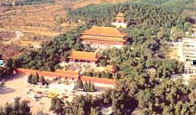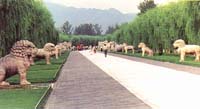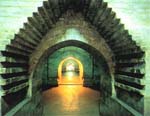Online Courses
Study in China
About Beijing
The Ming Tombs
 The Ming Dynasty lasted from l368 to l644. The first Ming Emperor (Zhu Yuan Zhang) had his tomb built in Nanjing, the town which he had chosen for his capital. As his eldest son died early, Zhu Yuan Zhang was succeeded by his grandson, who became the second Emperor. His fourth son, the Prince of Yan, was guarding the northern frontier near Beijing with an army l00,000 strong. The second Emperor attempted to weaken his forces but was met with counter-attacks. After a 3-year war he was ousted and lost track off completely. So, the fourth son became the third Emperor, Emperor Yongle, of the Ming Dynasty.
The Ming Dynasty lasted from l368 to l644. The first Ming Emperor (Zhu Yuan Zhang) had his tomb built in Nanjing, the town which he had chosen for his capital. As his eldest son died early, Zhu Yuan Zhang was succeeded by his grandson, who became the second Emperor. His fourth son, the Prince of Yan, was guarding the northern frontier near Beijing with an army l00,000 strong. The second Emperor attempted to weaken his forces but was met with counter-attacks. After a 3-year war he was ousted and lost track off completely. So, the fourth son became the third Emperor, Emperor Yongle, of the Ming Dynasty.
 As a frontier commander, he was aware that a peaceful northern frontier was of great importance to the Ming regime and the unification of the country. Yongle moved the capital to Beijing in early 15th century. Along with the construction of the Imperial Palace, he chose this valley to build his tomb. All his successors followed his example and had their tombs built here, except one who was dethroned and buried in the western suburb. Out of the sixteen emperors, thirteen lie here with their empresses and concubines. The site was chosen with the greatest care, with geomancy taken into account. The tombs are located about 50 kilometers to the north of Beijing. They are scattered over a basin approximately 40 square kilometers in area, screened by mountains on three sides and open to the Beijing Plain in the south. The road leading to the tombs is guarded by Tiger Hill on the left and the Dragon Hill on the right. It was a forbidden ground except for those who were officially in charge of its upkeep. It was not allowed to cultivate land, cut wood or to take stones from here. No one could enter it on horseback, even the Emperor himself had to dismount at the gate.
As a frontier commander, he was aware that a peaceful northern frontier was of great importance to the Ming regime and the unification of the country. Yongle moved the capital to Beijing in early 15th century. Along with the construction of the Imperial Palace, he chose this valley to build his tomb. All his successors followed his example and had their tombs built here, except one who was dethroned and buried in the western suburb. Out of the sixteen emperors, thirteen lie here with their empresses and concubines. The site was chosen with the greatest care, with geomancy taken into account. The tombs are located about 50 kilometers to the north of Beijing. They are scattered over a basin approximately 40 square kilometers in area, screened by mountains on three sides and open to the Beijing Plain in the south. The road leading to the tombs is guarded by Tiger Hill on the left and the Dragon Hill on the right. It was a forbidden ground except for those who were officially in charge of its upkeep. It was not allowed to cultivate land, cut wood or to take stones from here. No one could enter it on horseback, even the Emperor himself had to dismount at the gate.
 The thirteen Ming tombs are similar in structure but different in scale. Chang Ling "ling" means mausoleum is the biggest. Located at the foot of Mount Tianshou and built over a period of 18 years, it is the tomb of Emperor Yongle and his queen. The main above ground structure is Ling En dian, or Hall of Eminent Favors. A twin-roof building on a three-tier white marble terrace with balustrades all around, it is as magnificent as the Hall of Supreme Harmony in the Forbidden City. The roofs are supported by 32 giant columns made from single tree trunks. The tumulus lies below a mound behind the hall. The tumulus has not been excavated, and archaeologists around the world have speculated on its contents. Of the Ming tombs, only Ding Ling has been excavated. The mausoleum of Emperor Wanli and his two queens, it has an underground palace with a total floor space of 1,195 square meters. It is divided into several vaulted chambers free of beams. Two marble doors are made of single slabs and carved with life-size human figures, flowers and birds. More than 3,00 articles have been unearthed from the tumulus, the most precious being the gold crowns of the emperor and his queens.
The thirteen Ming tombs are similar in structure but different in scale. Chang Ling "ling" means mausoleum is the biggest. Located at the foot of Mount Tianshou and built over a period of 18 years, it is the tomb of Emperor Yongle and his queen. The main above ground structure is Ling En dian, or Hall of Eminent Favors. A twin-roof building on a three-tier white marble terrace with balustrades all around, it is as magnificent as the Hall of Supreme Harmony in the Forbidden City. The roofs are supported by 32 giant columns made from single tree trunks. The tumulus lies below a mound behind the hall. The tumulus has not been excavated, and archaeologists around the world have speculated on its contents. Of the Ming tombs, only Ding Ling has been excavated. The mausoleum of Emperor Wanli and his two queens, it has an underground palace with a total floor space of 1,195 square meters. It is divided into several vaulted chambers free of beams. Two marble doors are made of single slabs and carved with life-size human figures, flowers and birds. More than 3,00 articles have been unearthed from the tumulus, the most precious being the gold crowns of the emperor and his queens.
